
The taxonomy of contemporary classical music—new music, contemporary music, whatever you want to call it—is a thorny issue. That ambiguity makes rating the year’s best offerings difficult, if not impossible, but embracing the big picture of musical diversity that these 10 albums have delivered all year long has provided excitement, asked questions, and explored disparate sorts of beauty. These are the best contemporary classical albums of 2023 in alphabetical order.
Lucia Dlugoszewski
Abyss and Caress




Compact Disc (CD)


A gradual rediscovery—or better yet, just a discovery—of the music of Polish-American composer Lucia Dlugoszewski seems to be underway, and it’s about time. My own introduction occurred only a couple of years ago with an album by Italian pianist Agnese Toniutti, who performed a work the composer had written for “timbre piano,” which installed fixed and mobile preparations as percussive devices in the instrument. That piece is but a small part of a much larger body of work, much of it written for modern dance. This essential double album from Klangforum Wien offers the broadest portrait of Dlugoszewski’s work yet, with pieces ranging from 1952—when she was a close friend of John Cage—up through 1995, when she wrote the bracing string quartet Disparate Stairway Radical Other. Apart from serving up powerful accounts of some previously recorded pieces, the ensemble invaluably presents the first recordings of two monumental works from the early 1970s. The title composition, from 1975, is a bruising orchestral work featuring harrowing solo trumpet. Dlugoszewski wrote often for brass, specifically for the virtuosic trumpeter Gerard Schwartz. The role is filled here by Peter Evans, a superhuman on the instrument, who rips through the demanding score with gusto and mind-boggling precision, amid a visceral ensemble performance conducted by Ilan Volkov, a fervid champion of the composer’s music.
Jürg Frey
Continuité, fragilité, résonance

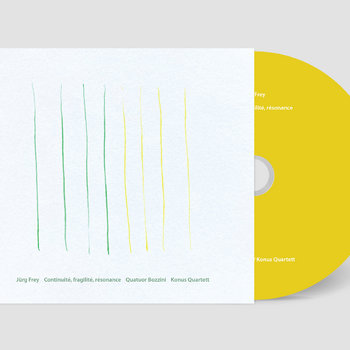


Compact Disc (CD)


Some of the most indelibly gorgeous music by Swiss composer Jürg Frey has been written for different sorts of quartets, and this stunning new work enlists two of the finest such ensembles he’s worked with: the strings of Montréal’s Quatuor Bozzini and the saxophones of Bern, Switzerland’s Konus Quartett. As with all of his work, the music emerges from silence and retains a meditative stillness, even when lines begin to intersect and harmonies blossom. As the composer notes in an interview with Elsewhere Music’s Yuko Zama, the various notes each musician plays are quite simple, “but it takes time for a performer to understand the music and the context of these single notes.” Indeed, the architecture is constantly, patiently shifting, with new combinations emerging at a steady but leisurely clip. A foundation of sumptuous, floating long tones seems to nourish spry bits of counterpoint that evolve, gaining complexity, as the 50-minute composition unfolds. Each new section unleashes a universe of harmonies, alternately characterized by ethereal beauty, dramatic beating, and spooky portent. Frey’s masterful writing blurs the seemingly distinct sound worlds of strings and reeds, not only making it hard to tell which is which, but often evoking the sounds of other instruments, whether organ or brass. It’s a work of profound depth and beauty as ravishing as anything in Frey’s vast oeuvre.
Catherine Lamb
parallaxis forma

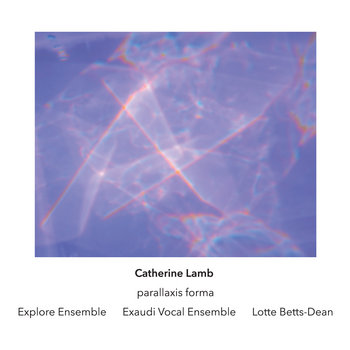

Compact Disc (CD)

One of the most encouraging things to observe while writing this column over the years is seeing how certain new works are embraced, creating a new canon of contemporary music. Regular readers have surely noticed my deep admiration for Catherine Lamb’s music, so it’s fantastic to see how more musicians are taking on her work—not just the ones who’ve commissioned it. This collection focuses on some of her pieces for voice, tackled by some of England’s most adventurous and committed musicians. Both “Color Residua” and the title piece were composed around the same time, and they explore the way sounds morph as the shape of the mouth changes to produce different vowels. On the first piece, a string quartet drawn from members of Explore Ensemble form a harmonically rich foundation for the braided voices of Juliet Fraser, Cathy Bell, and Michael Hickman (all members of the vocal group Exaudi). The result is a riveting stream of constantly changing long tones that recalls some imaginary liturgical tradition. Lamb herself has described this as “after-image studies,” where three fused voices produce lingering shadows carried over by four string instrumentalists.” “Pulse/Shade” is written for two vocal duos, but here Lotte Betts-Dean overdubs all four wordless parts, which play out in four sections with steady alteration in attack, consonance, and tension of vowel sounds. The singer is also the focus of title work, in which the members of Explore extract “the tonalities from the phonetic timbres.” It’s an extraordinary collection, and it gives me hope that more folks will encounter Lamb’s music.
MEV
Symphony no. 107 – The Bard

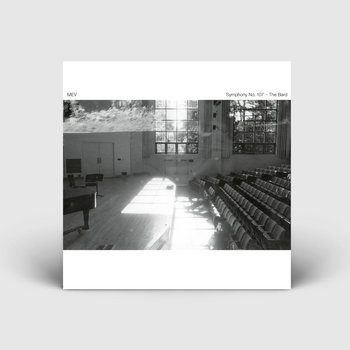

Vinyl

The long-running experimental juggernaut MEV (Musica Elettronica Viva) was formed in Italy back in 1966. It lost two-thirds of its core in 2020 and 2021 with the respective deaths of Richard Teitelbaum and Frederick Rzewski, ending an incredible run of collective creativity. This previously unreleased live recording made at Bard College in 2012 is a testimony to MEV’s rigor and vitality. As with the group’s other member Alvin Curran, Teitelbaum and Rzweski were both excellent composers, committed chance-takers, and improvisers. In their performances—including this superb concert—they conjured a lifetime of material on the fly, linked by some kind of telepathic communication that imbued their improvisation with a deep compositional logic. The music builds from near-silence to unleash a spirited collage of texture and gesture, constantly mutating and blending, with live instrumental bits—on piano, shofar, or harmonica—seeping in, sometimes taking over, or blending within electronic soundscapes. The performance builds in density over time, with each musician meticulously pushing ahead while deftly responding to (or ignoring) elements that arise suddenly, whether a punishing hip-hop sample, frictive crunching, or squelching electronic tones. Anything was fair game in MEV’s world, but any element plucked from their deep sonic arsenal was chosen with intention, either complementing and enhancing the playing or carefully diverting it.
Cassandra Miller
Traveler Song/Thanksong

Vinyl

It’s hard for me to think of anyone making music as distinctive as Cassandra Miller, a Canadian composer living in London. Her work is bracingly fresh while maintaining a strong connection to tradition. These two works use source material from the past that would just be impressively clever if the results weren’t so astonishing. “Traveler Song” employs a practice she’s developed over time, where she listens to a piece of folkloric music—in this case, a recording of a Sicilian cart driver (il carrettiere) made by Alan Lomax and Diego Carpitella—on headphones, with the volume loud enough that she can’t hear her own improvised vocal response, which she then tapes. Miller repeated the process several times, her wobbly, wordless singing spinning off into something otherworldly, yet rooted in the quotidian. She then wrote a gorgeous arrangement for London’s Plus-Minus Ensemble to play alongside the recording of her own voice—first with solo piano, carefully limning her singing, before the rest of the acoustic ensemble enters with airy, delicate counterpoint appearing in various combinations around an evolving guitar figure. The piece first appeared on a fantastic album called Songs About Singing released in 2019 and four years and many spins later it’s lost none of its magic or beauty. “Thanksong” is derived from the third movement of Beethoven’s late quartet in A minor (op. 132), using similar methods, with Miller recording improvised singing to each of the four string parts. Then, the members of Montréal’s masterful Quatuor Bozzini play by ear to those lines, which they hear on headphones. The remarkable singer Juliet Fraser then sings melodies from the quartet “as slowly and quietly as possible,” her peerless soprano overlapping with some of Miller’s original responses. The connections to the source material are ineffable and real, but they serve something powerfully new.
Éliane Radigue
Naldjorlak

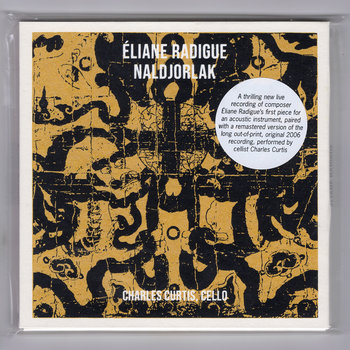
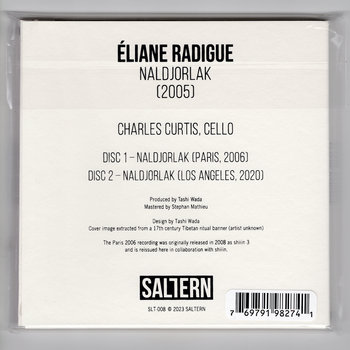

Compact Disc (CD)


This astonishing double CD collects two performancesof Naldjorlak—one recorded in 2006 in Paris and one in 2020 in Los Angeles—by the cellist Charles Curtis, who collaborated on this piece with the singular French composer Éliane Radigue in 2005. After spending decades creating electronic music, this epic became her first composition for acoustic instrumentation. The duo built the music around the “wolf tone” of the cello, when a particular pitch activates the resonant frequencies of the instrument’s wooden body—becoming wildly unstable and unleashing all sorts of sounds that conventional Western music has sought to banish because they consider them impure and distracting. Rather than eschewing this remarkable sonic effect, Curtis and Radigue developed an entire piece that explores the wolf tone across the entirety of the instrument’s range, tuning three of the instrument’s strings to this pitch area, while adjusting the fourth to project those volatile frequencies onto the cello’s metal tailpiece. As Curtis proceeds, our ears gravitate toward the often tremulous bowed sounds he’s struggling against science to maintain. At some point, we begin to hear the effects of the wolf tone: amorphous rumbles; whirling, whistle-like sounds; turbulent jitters that seem three-dimensional; and more. Beyond the actual arco lines Curtis opens up a veritable universe of sound and motion, a thrillingly unstable demonstration of acoustic phenomena that captures musical performance at its most exciting, unpredictable, and dangerous. Fourteen years separate the two accounts, but the piece can never sound the same twice. Curtis is getting more out of it than ever.
Linda Catlin Smith & Thin Edge New Music Collective
Dark Flower
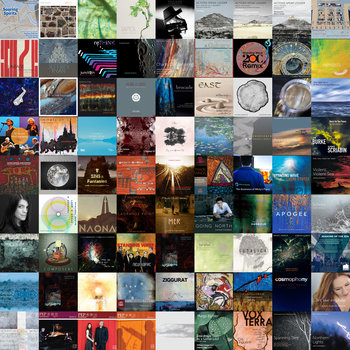



Compact Disc (CD)


Years before composer Linda Catlin Smith began to gain an international profile through a series of superb recordings for the label Another Timbre, Toronto’s Thin Edge New Music Collective—co-founded by the pianist Cheryl Duvall and violinist Ilana Waniuk—was already devoted to her music. In fact, its first ever performance in 2011 featured an account of her piece “With Their Shadows Long,” which remains part of the ensemble’s repertoire. As with so much of Smith’s rapturous music, it’s steeped in dark harmonies, with a beautifully sorrowful melodic thrust that inches along slowly, hanging in the air, reveling in a dusky ambience. While a number of works on this impressive portrait album have been previously recorded, including the otherworldly opener “Wanderer”—an airy dirge suffused with attractive stillness and a distant percussion-fueled tension—the album provides the first recordings of four compositions, including the titular centerpiece, which the ensemble commissioned for a 2020 performance. On that 26-minute shape-shifting marvel, violin, viola, and cello levitate over, blossom through, and strain against sparse piano parts—stark single note patterns, patient arpeggios, and insistent chording. All of Smith’s music is rooted in classical tradition, but she routinely applies discordant harmonies, molasses-slow pacing, and powerful patches of silence, which makes it all feel totally contemporary. The composer was involved in the recording project, leaving the impression that these are exemplary readings of her work. Sure sounds that way.
Henry Threadgill
The Other One



Compact Disc (CD)

Few composers and musicians have managed to build a body of work that feels as connected and radically evolving as Henry Threadgill. This new album contains a three-movement work entitled Of Valence, dedicated to the master percussionist Milford Graves and filled by Threadgill’s distinctive ideas, particularly the interval-based system originally deployed by his long-running chamber group Zooid. Here, he conducts a 12-member ensemble featuring several Zooid members—pianist David Virelles, cellist Christopher Hoffman, and tubist José Davila—which masterfully injects improvised passages within an elegantly shape-shifting landscape that percolates with dancing, splintered grooves. Threadgill has always explored unusual timbres, and he’s at it again here, arranging a bracing string section with a reed ensemble that includes a pair of bassoonists. By the end of the work, though, any sense of novelty has been destroyed by how vitally those elements interact, pushing and pulling, opening up space and then filling it. During a time when many of his AACM colleagues have produced more fully notated works for other ensembles than ever, Threadgill maintains an autonomy that leaves no room for misinterpretation or flatness. In a recent New York Times profile the composer said, “I don’t like preconceived forms, you know? I like to create new forms.” Indeed, that’s always what he’s done, never more convincingly than with The Other One—at once instantly recognizable as signature Threadgill while simultaneously exploring new terrain with stunning rigor.
Ben Vida with Yarn/Wire & Nina Dante
The Beat My Head Hit



Vinyl LP

Veteran experimentalist Ben Vida spent four years developing the five pieces of this mesmerizing work with pianist Laura Barger and percussionist Russell Greenberg of New York’s Yarn/Wire, and the results take their time sinking their teeth into the consciousness. That slow burn makes sense considering the detail in Vida’s texts, which he recites in a sort of incessantly rhythmic chant—albeit one in constant flux—in tandem with vocalist Nina Dante. At first blush, the vocals seem flat and impassive. But over time, they gain resonance—especially as one begins to suss out the ever-shifting phrasing and rhythmic play. By the end, both Vida and Dante’s performances are clearly virtuosic. The meaning of the texts seems intentionally fuzzy, with bits and pieces of understanding emerging over time, or certain phrases standing out and making an elusive impact. Just as patiently Yarn/Wire’s minimalist soundscape reveals itself, with new details oozing out of the cyclical piano and vibraphone patterns bar by bar. There are wordless vocal harmonies floating in the distance on “Who’s Haunting Who Here?” The steady left-handed piano note in “Drawn Evening” takes on a directional role, grounding a spacious, slow-moving soundscape that opens the most delicate and barren stretch of the album, even as it fades deep into the mix and its rhythm is passed to a cymbal. The Beat My Head Hit is unlike anything I’ve heard in a long while, and if my listening thus far is any indication, it’s got a lot more secrets to give up in the future.
Eric Wubbels
If and Only If






Sheet Music, Compact Disc (CD)




Composer and pianist Eric Wubbels has worked with violinist Josh Modney and cellist Mariel Roberts for many years, both in Wet Ink Ensemble and in this stand-alone trio. The trust and familiarity they’ve developed over time seems essential to the success of this remarkable piece of music, written for them between 2018-2019. The eight-movement piece moves seamlessly through different tuning systems, enlisting the musicians to move from strength-to strength while navigating the pleasingly thorny. The whole thing opens in “endings,” with Wubbels playing an oblique chord in unison with dense, sustained double stops from the strings deployed using just intonation. It fosters a remarkably viscous, kaleidoscopic harmony that feels simultaneously oppressive and shimmery. Wubbels drops in thunderous lower register tones here and there, but the focus is on Modney and Roberts as they cycle through a variety of lush chords, eventually thinning out the sound as it progresses. Thus begins an utterly absorbing hour-long journey through shifting harmonies, unison patterns, and collisions between JI tuning for the strings and the piano’s equal temperament. But Wubbels, as usual, is interested in more than just harmonic explorations, playing with scale, arrangements, and dynamics. The second movement, “tombeau,” flips the script and moves the piano to focal point, with the strings grinding against the glassy arpeggios and flickering runs in concentrated, viscous swells. Each additional movement changes perspective and tonality, offering a dazzling variety of shapes and colors fueled by the collective enterprise these musicians have devoted themselves to, shepherded along by the pianist’s incisive writing.







